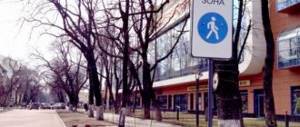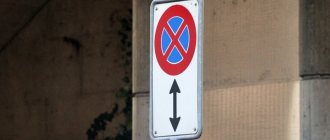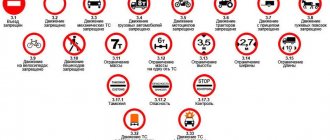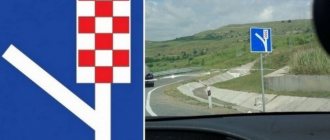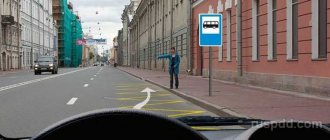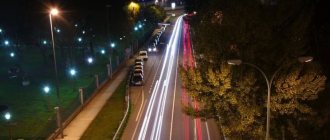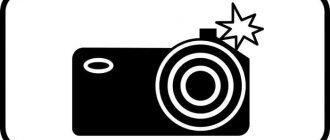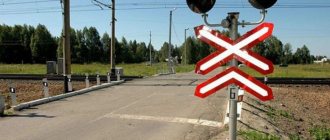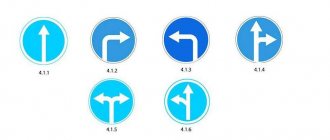Fines
The procedure for assigning and the amount of the fine, as before, is determined by Article 12.19 of the Code, but taking into account local regulations:
- warning;
- 1500 rubles (most regions of the Russian Federation);
- 3000 rubles Moscow, St. Petersburg;
- vehicle detention;
- sending to a special parking lot;
- payment for transportation and storage in a special parking lot.
A driver will receive a more serious financial penalty (up to 5,000 rubles) for stopping in a place where there is a “Disabled” road sign. Additional punishment will be received if the violation is recorded in a tunnel or at a pedestrian crossing.
In 2021, the procedure for imposing administrative fines in 2016 has changed. Previously, inspectors could record violations using tablets. Now special applications have been released for the mobile devices owned by many pedestrians. Anyone who purchases this application can record a violation of the “no stopping” condition and send a video file to the traffic police database. In this way, they began to fight against violations of traffic and parking rules in residential areas of cities and towns.
What are the fines?
There are a dozen penalties for violating parking rules in places where it is prohibited. The good news is that you cannot lose your license for an incorrect stop (with rare exceptions), but the bad news is that the penalties may exceed the cost of paid parking.
Let's look at them all!
Fines for illegal parking
| Article of the Administrative Code | Amount of fine, rubles | Is evacuation planned? |
| 12.16, parts 4 and 5 – Parking under a prohibition sign or on markings | 3000 for Moscow and St. Petersburg 1500 for other cities | Yes, but only if there is an evacuation sign (Article 27.13 of the Administrative Code) |
| 12.19, part 2 – Stopping and parking in places for the disabled | 5000 | Yes |
| 12.19, parts 3 and 6 – Parking on a zebra crossing or less than 5 meters in front of it, violation of stopping on the sidewalk | 3000 for Moscow and St. Petersburg 1000 for other cities | Yes |
| 12.19, parts 3.1 and 6 – At designated stops (if there is no interference with minibuses, otherwise see part 4 of article 12.19) and closer than 15 meters in front of them | 3000 for Moscow and St. Petersburg 1000 for other cities | Yes |
| 12.19, parts 3.2 and 6 – Stopping further than the first row of the edge of the roadway or on tram tracks | 3000 for Moscow and St. Petersburg 1500 for other cities | Yes |
| 12.19, parts 4 and 6 – Parking that interferes with other participants, or in a tunnel | 3000 for Moscow and St. Petersburg 2000 for other cities | Yes |
| 12.10, part 1 – Stopping and parking at the railway crossing | 1000 rubles or deprivation of rights for 3-6 months | No |
| 12.10, part 3 – Repeated parking at the railway crossing | Deprivation of rights for a year | No |
| 12.10, part 1 – Any other traffic violations regarding parking not listed above | 500 | No |
Where is it prohibited to stop a vehicle?
Who can drive under the traffic sign is prohibited.
Prohibition signs It is not always possible to leave your car where you need it. If it is not always possible to comply with traffic rules, then be prepared for fines. Places where you are not allowed to stop are usually marked with a sign. But you need to take into account that they are not installed everywhere. The driver must remember the places where stopping the vehicle can lead to unpleasant consequences due to difficult conditions.
It is prohibited to stop at a pedestrian crossing, or within five meters in front of it. But you can park your car right behind the zebra crossing. This is done specifically so that a driver passing along the road can react in time to the appearance of a pedestrian.
You cannot leave your car on the tram tracks. It is also prohibited to do this in close proximity to them. Since the tram cannot leave the track, it means that your car will disrupt the public transport schedule.
It is prohibited to park your car in a designated lane reserved for mopeds and cyclists. Of course, not only stopping, but also driving cars is prohibited on a dedicated lane.
You cannot park a vehicle at intersections, as well as in the area adjacent to the intersection of roads closer than five meters. This prohibition does not apply at T-junctions if the driver stops the car opposite the road, which is perpendicular to the roadway. This is possible if there is a continuous marking line between the side road and the stopping place.
You must not abandon the car near a dangerous turn; it is also prohibited to do this in places with a significant difference in elevation, if visibility in any direction is less than 100 meters.
Keep in mind that the car should not block road signs, impede the entry/exit of other vehicles, block traffic signals, or interfere with pedestrians.
You should not leave your car on a narrow road. By stopping, you force drivers of passing vehicles to cross the road, and this is strictly prohibited. You can only stop in a place where there is a distance of more than three meters to the opposite edge of the roadway.
Video: Area of operation of the stop and parking sign is prohibited and a fine for violating the sign.
Conclusion
Always pay attention to where you are going to park your vehicle. It is best to do this in specially designated areas
In the event of an unforeseen situation, be sure to put up an emergency sign. If you do not do this, you will be issued a fine if you stop the vehicle in the wrong place.
On lawns and courtyards near houses
But this case is no longer described in the traffic regulations in force for 2021. You simply won’t find a ban on parking on a lawn, or a definition of a lawn in the Rules. And also a similar ban on courtyard areas.
But indirectly this issue is regulated by clause 12.1:
12.1. Stopping and parking of vehicles is permitted on the right side of the road on the side of the road, and in its absence - on the roadway at its edge and, in the cases established by paragraph 12.2 of the Rules, on the sidewalk.
The lawn does not belong to the roadway and the side of the road. It is not part of the road at all. Therefore, stopping there is prohibited. A similar prohibition is contained in the legislation of the constituent entities of Russia. Thus, the laws of Moscow and St. Petersburg define a lawn and directly state that parking there is prohibited. At the same time, it is not necessarily the presence of grass that is considered a lawn - a piece of bare earth also formally fits this definition.
Similarly, a fine for stopping on the lawn is issued at the level of individual cities. It varies by region and ranges from 4 to 5 thousand rubles.
There is also no direct ban on parking in courtyards. But there are traffic rules in the courtyards. This is where the prohibitions arising from the traffic rules follow. And most often, drivers who leave cars in courtyard areas may violate the following regulations:
- what we have already discussed above - parking on the lawn,
- less than 3 meters to the opposite edge of the roadway (clause 12.4),
- the car is not parked parallel to the inverter (clause 12.2).
Towing for illegal parking
Parking signs for even and odd days of the month in Russia in 2018
Thus, no-parking zones make it possible to normalize traffic and prevent the situation from worsening and even causing a collapse in traffic.
Some drivers are of the opinion that you can park your car anywhere in the yard. This is wrong!
Our car spends the night, parked on the edge of the parking lot adjacent to the building: behind the wall of the building, on the right there is a curb, a lawn and parking for bicycles installed on it (passing is not possible), on the left there is a parallel car, the owner of which also left it for a week/month in the parking lot, usually There is a road ahead and a free exit.
Some drivers are of the opinion that you can park your car anywhere in the yard. This is wrong!
Our car spends the night, parked on the edge of the parking lot adjacent to the building: behind the wall of the building, on the right there is a curb, a lawn and parking for bicycles installed on it (passing is not possible), on the left there is a parallel car, the owner of which also left it for a week/month in the parking lot, usually There is a road ahead and a free exit.
Stopping and parking on the left side of the road is permitted in populated areas with one lane for each direction without tram tracks in the middle, as well as on one-way roads if there is a sidewalk immediately adjacent to the roadway on the left.
Marking
Where there is a paid parking sign, the markings are used to delimit spaces for cars, or indicate the beginning and end of this territory. Line 1.2.1 is drawn directly from 6.4+8.8. You can cross it to enter the parking lot. Markings 1.1, 1.4, 1.10 are applied where it ends. It is prohibited to cross them.
The markings that cause the most confusion among drivers are semicircular. It is used to mark areas for turning. It is a solid line. And as subclause 12.4 of the traffic rules prescribes:
Stopping is prohibited: ... in places where the distance between the solid marking line (except for the edge of the roadway) ... and the stopped vehicle is less than 3 m; ...
Mentioned in paragraphs
Road signs for traffic rules 2021 and their designations
: within the coverage area of the road sign 326
;
: sign - “The end of all restrictions.” Indication of the end of the coverage area simultaneously with the signs , , , , , 326
, , And ;
: Within the sign's coverage area 326
allowed:
: Local governments have the right, by their decision, to establish the period of time during which the loading or unloading of vehicles is permitted in the area covered by the signs. 326
, , And .
: Action of signs, 326
, , and applies only to the side of the roadway on which they are installed.
: Sign area , , , , , 326
, , and extends from the place where the sign is installed to the intersection closest to it, if there is no intersection, to the sign, and if the sign is installed in front of a populated area, to the sign. The coverage area of the signs does not end at exit points from areas adjacent to the road (yard, parking lot, gas station, enterprise, etc.) and in places where the road is crossed or branches off by a field, forest, etc. road, in front of which there are no signs corresponding priority signs.
: for signs , , , , , 326
, , and by installing the sign or ;
: for signs 326
, , and - by reinstalling the corresponding sign
326
, , or together with the sign at the end of the coverage area.
Sign 326
can be used in conjunction with road markings, and the sign can be used with road markings.
In these cases, the coverage area of the signs is determined by the length of the road marking line. The coverage area of signs 326
, , and also ends at the places where the sign or parking place designated by the sign begins on the roadway and sidewalk.
: sign - “Parking area”. The sign's coverage area extends from the place of its installation to the nearest intersection behind the sign, and if there is no intersection, to sign 532A, , 326
, , or . The lower part of the sign may indicate the direction of travel to a parking area located in close proximity to the road. The building roof symbol indicates an underground or above-ground multi-story parking space. In the parking lot, the prohibitions established by subparagraphs and;
: sign - “Paid parking place”. The sign's coverage area extends from the place of its installation to the nearest intersection behind the sign, and if there is no intersection, to sign 533A, , 326
, , or . The sign may indicate the maximum duration of parking, for which payment can be made immediately. The lower part of the sign may indicate the direction of travel to a parking area located in close proximity to the road. In the parking lot, the prohibitions established by subparagraphs and;
: additional signs , and - “Validity area”. Indicates the direction and coverage area of the signs 326
, , and , if stopping or parking is prohibited along one side of the square, the facade of a building, etc. With an additional sign and also indicates the distance to the object indicated by the sign or , and with an additional sign - the coverage area of the sign and , if they are installed parallel to the edge of the parking lot;
: additional sign - “Area of Operation”. Informs the driver that he is within the sign's coverage area 326
, , And ;
: additional sign - “Area of Operation”. Indicates the end of the sign's coverage area 326
, , And ;
: additional sign - “A tow truck is working.” An additional sign is installed together with the sign 326
, , and , as well as without the indicated signs in places where parked cars interfere with entry or exit from courtyards and other places;
: additional sign - “Other information”. Provides information that other additional signs do not contain (cancels the ban on stopping and parking vehicles with special permits in the area where the signs are valid 326
, , and (the driver must place the permit in the car near the front window), indicate the period of time during which it is allowed to load or unload cargo, provides information regarding the peculiarities of organizing the movement of bicycles one-way, two-way traffic, traffic on a one-way road towards the general flow of vehicles, etc.) or bicycle routes (on a green or blue background), etc.;
: road markings - a solid yellow line - are applied at the edge of the roadway or along the top of the curb and indicate a section of the road where stopping and parking of vehicles is prohibited. Can be used alone or in combination with a sign 326
;
: Subparagraph of these Rules comes into force on January 1, 2006. Until December 31, 2005, minibus drivers are allowed to pick up and disembark passengers within the coverage area of the road sign. 326
.
Parking parallel to the edge of the roadway
A “Parking” sign installed without a sign with a limited coverage area is valid until the nearest intersection. The “Method of vehicle stowage” sign must always be installed with this sign. This combination can be used to designate a paid parking zone. Do not forget about the prohibition of parking closer than 5 meters to the edge of the roadway being crossed.
Paid parking parallel to the edge of the roadway
Parking rules before and after the pedestrian crossing
Section 12 of the Traffic Regulations talks about when parking and stopping are permitted or prohibited. Both pedestrians and drivers must understand that a vehicle stopping directly in front of a zebra crossing will simply block the view of other road users. This is extremely dangerous, since cars approaching the crossing may not see people crossing the road, because they will be blocked by an illegally parked car. In fact, there are a lot of such sad situations when a pedestrian suddenly appears in the center of a zebra crossing unexpectedly for the driver. And it’s good if the reaction does not let the motorist down. But sometimes it is not enough to press the brake quickly, since the weight of the car will still not allow it to stop instantly. If you need to park and there is a pedestrian crossing nearby, you must follow the following rules:
- Parking or stopping directly on the zebra crossing is prohibited.
- Parking in front of a pedestrian crossing is possible and acceptable if there is more than 5 meters left to it.
- If you want to leave your car behind a zebra crossing, remember that you cannot run over the markings.
- Estimate the width of the stripes if they are separated by a solid marking line. Your car must not interfere with the movement of other vehicles; for this, the distance from the solid line to the parked car must be 3 meters or more.
When choosing a parking place, look at the signs and remember the traffic rules - in some places parking is prohibited. As a rule, it is unacceptable in the same place as the stop, which we will discuss below.
How to choose a place to stop at a pedestrian crossing?
Often, drivers do not understand the difference between the concepts of “stop” and “parking”. And it exists and is very significant. We talked about parking above. A stop assumes that the motorist will deliberately stop driving for a time that will not exceed 5 minutes. Perhaps more, but then the stop must have a specific purpose - boarding (disembarking) passengers or unloading (loading) cars. That is, the difference in terms lies in the time interval.
Here are examples of stopping:
The driver deliberately stopped driving the car for 4 minutes 50 seconds
This will be a stop, and it does not matter at all what the people in the car were doing at the time in question. If there is a deliberate stop to the movement of the vehicle for the purpose of unloading the vehicle. The duration of the process is not taken into account; you can unload for at least 15 minutes, at least an hour. It was necessary to disembark passengers
The time interval also does not matter.
When choosing a place to stop, you need to be careful and look around. There is a possibility that it is impossible to perform such an action on the selected section of the road according to the traffic rules. For example, there is a sign “No stopping”, etc. When looking for a place to stop, you should use the rules stated in the traffic rules. It is prohibited to stop:
- On rails intended for trams, as well as near them;
- At railway crossings, bridges, tunnels, overpasses, etc.;
- At the zebra crossing and closer than 5 meters in front of it;
- Less than 15 meters from a public transport stop. It can be indicated either by markings or by a sign. The exception is the embarkation and disembarkation of people;
- On a road with dangerous turns or heavy traffic;
- In a lane reserved for cyclists;
- If your car interferes with other road users. For example, it will interfere with pedestrians, obscure road signs or traffic signals from other motorists, etc.;
- At an intersection and closer than 5 meters from the edge of the roadway (the one you are crossing);
- If the distance between your car and the solid line demarcating the lanes (if any) is less than 3 meters.
The same requirements apply to parking, but two more are added: parking is prohibited on the roadway of the main road if you are traveling outside a populated area, and at a distance of less than 50 meters from a railway crossing.
Distance to pedestrian crossing when parking
It was noted above that when parking in front of a pedestrian crossing, you need to stop driving 5 meters or more from it. You should follow the markings or signs. Moreover, it is worth understanding that the distance is determined from the most protruding part of the car to the “pedestrian” sign or the beginning of the marking. The zebra itself is not taken into account.
When parking after crossing, you can not pay attention to the distance to the markings if you parked on the right side of the road or the traffic is one-way. If you have chosen the left lane on a two-lane road with oncoming and passing traffic, then you should drive through the crossing and stop the car 5 or more meters from it.
Parking allowed
Car parking rules allow long-term parking in the following places:
- If there are no prohibition signs on the right side of the road in the direction of traffic. The shoulder is considered to be the part of the road behind the markings separating the roadway.
- From the right edge of the road, if there is no shoulder. You must first make sure that there is 3 m or more left from the car to the marking line for the unhindered movement of other vehicles. Motorized vehicles are allowed to park in one or two rows.
- On both sides of a road that does not pass through a populated area, and in areas with one-way traffic without tram rails.
Freight transport with a carrying capacity of 3.5 tons or more can only make a short stop on the left edge of the road.
If there is a permit sign, partial or full parking on the sidewalk is allowed. An additional sign may indicate how to park the car correctly.
Carrying out sign instructions
You can avoid paying fines for illegal parking if you correctly interpret the installed road signs. It is necessary to take into account the saying: “what is not prohibited is permitted.” The legal interpretation regarding these actions is appropriate to apply here. Therefore, it is recommended to know the traffic rules so as not to find yourself in an undesirable or ambiguous situation.
When installing signs prohibiting parking and stopping, traffic police officers are guided by certain rules that allow them to clearly and unambiguously regulate the traffic situation. This way we can achieve the following result:
- Threat to traffic safety is not allowed;
- there are no obstacles to the free movement of pedestrians and vehicles;
- There are no violations of traffic rules by vehicles forced to go around an illegally parked car.
When considering the difference between signs prohibiting parking and stopping, you need to take into account that in the first case it is forbidden to stop driving, and in the second - the effect of the sign allows the speed to be reduced to 0 km/h, but the driver should not leave his vehicle for a long time. A round sign with one red line crossed out at an angle will not allow long-term parking, and if there are two crossed red lines in a circle, a ban is imposed not only on parking, but also on stopping.
It is from under the circle, edged with a red stripe with a blue base and a red “X” inside, that tow trucks take away our cars. Everyone, including people with disabilities, must obey this sign. An exception is allowed only for route vehicles.
A road sign prohibiting parking has slightly different instructions. It allows the possibility of parking vehicles transporting disabled children or persons with disabilities of the 1st or 2nd group. Taxi drivers running a meter or a postal service vehicle have the right to legally ignore the ban.
Fine for non-payment
It is clear that those who do not pay for the service will be punished. Fines are imposed in accordance with regional laws. In Moscow it is 2500 rubles, in Kazan – 1000 rubles, there are cities where the amount is 5000 rubles. And the car will be evacuated to a special parking lot, from where it will have to be rescued for a separate fee.
But sometimes it happens that there is no paid parking sign, but you receive a fine. It must be contested by first filing a complaint with the city agency responsible for organizing this type of parking. If this does not help, you should go to court.
The paid parking sign has already become part of the road infrastructure. Neglecting it will result in higher costs than the standard service fee. But if one of the signs is missing, parking becomes free.
Current terminology
All car owners undergo license training within several weeks. However, just a few months after receiving a driver’s license, most cannot correctly formulate the difference between a stop sign and a no-parking sign. Although these road signage elements are found almost everywhere in urban environments.
Explanation of terms and the difference between parking a car and stopping it is given in the current traffic rules, clause 1.2. Based on the interpretation in which a stop is less than a five-minute cessation of movement, many drivers mistakenly interpret a stop as a more than five-minute cessation of movement. In reality, this is not a completely correct interpretation of the traffic rules.
An example is one of the cases when several tons of vegetables were brought to the store by truck. Complete unloading requires a time investment of more than an hour. In this position, the car, while unloading continuously, is in a stopping position and has the right to behave in a similar way where signs are installed prohibiting parking (parking) for a long time, but allowing stopping. The same rule applies to passenger transport that disembarks passengers more than 5 minutes in advance.
The situation is completely different when the driver stops moving his vehicle to perform, for example, the following actions:
- look into the store for a pack of cigarettes;
- buy a fresh newspaper;
- add gasoline to the fuel tank;
- wipe the headlights or windshield from dirt, etc.
If the process lasts more than 5 minutes, then these actions are no longer a stop, but fall under the interpretation of the concept of parking. For this action, you must choose the appropriate place permitted by traffic rules.
When deciphering the meaning of the concepts of “parking” and “stopping”, it is necessary to take into account that both actions are used consciously by the driver. The movement of the vehicle is stopped intentionally for a period of time set by the driver.
In addition, traffic rules allow a forced stop, even where the stop sign and parking are prohibited. It is carried out not at the request of the driver, but due to a combination of external circumstances. According to the rules, it is impossible to prohibit a forced situation. In this regard, parking rules do not apply to this action of motorists or car professionals.
At the same time, during a forced stop, citizens driving a vehicle are assigned certain responsibilities that involve the following actions:
- mandatory activation of the emergency lights button;
- installation of a warning triangle;
- if possible, towing or rolling the vehicle to the side of the road or to the sidewalk;
- ensuring the passage of transport in the same or opposite direction, etc.
In practice, there are situations when stopping movement does not refer to either stopping or parking. An unintentional action takes place in front of a traffic light during a red signal or a few meters before a zebra crossing. This group includes standing in a traffic jam even where the area covered by the “no parking” sign extends.
How can I pay
Payment for the service is carried out in one of the following ways:
- Through a special terminal. This can be done using a scratch card or bank card purchased in advance from a mobile operator. One of them is inserted into the device, select the “Pay” option, enter the parking time, parking number, and other requested data.
- By sending an SMS to number 7757. It must contain vehicle data, parking time, and parking information. The money will be withdrawn from the phone. The stay time can be extended by sending an additional message, for example, “x1” (for 1 hour). Before leaving the place ahead of schedule, you should send an SMS with the letter “S”. The rest of the money will be returned to the owner.
- Through an application installed on the phone. You need to register on the city parking website and deposit funds into your account. When entering a paid parking lot, you should log into your account in the application and use the “Park” option. From this moment the countdown for the provision of the service will begin. When leaving, you need to use the “Leave” option.
More on AutoLex.Net:
How to do exercises on the race track
The payment can also be transferred through a regular terminal by selecting the appropriate section. Or buy a subscription valid for municipal commercial parking lots.
Places where parking is prohibited in 2019
Important. When considering traffic rules in terms of places prohibited for parking, it is worth distinguishing between the concepts of parking and stopping.
https://www.youtube.com/embed/H4Xej4zktCg. So, we found out that you cannot deliberately stop under a blue sign with a red cross.
Traffic police inspectors do not accept any excuses such as “dropping off passengers” or “I was just for a minute” - they issue a protocol on an administrative offense with a fine of 500 rubles (Article 12.19 of the Code of Administrative Offenses of the Russian Federation)
So, we found out that you cannot intentionally stop under a blue sign with a red cross. Traffic police inspectors do not accept any excuses such as “dropping off passengers” or “I was just for a minute” - they issue a report on an administrative offense with a fine of 500 rubles (Article 12.19 of the Code of Administrative Offenses of the Russian Federation).
What do our motorists usually do? They boldly park on the sidewalk and turn on the emergency lights, as if warning “don’t touch me, I’m broken!” But many do not do this either, believing that they have five minutes to run to the kiosk or drop off passengers.
That is, there is a parking ban in all places where a car can interfere with the passage of other vehicles or disturb the peace of pedestrians, but unfortunately, not all drivers comply with this rule.
At a distance of less than 50 m from the railway crossing. Then the country’s budget will have to be paid in accordance with Art. 12.10 Part 1 of the Code of Administrative Offenses 1000 rubles.
Parking on the edge of the sidewalk bordering the roadway is permitted only for cars, motorcycles, mopeds and bicycles in places marked with sign 6.4, with one of the signs 8.6.2, 8.6.3, 8.6.6–8.6.9.
Stopping is prohibited - at pedestrian crossings and closer than 5 m in front of them. The driver of car “A” is clearly violating the rules, because stands close to the pedestrian crossing. The driver of car “B” stopped behind a pedestrian crossing, which does not contradict the Rules. In a populated area, as in this situation, you can stop on the left side of the road, if there are no tram tracks in the middle of the roadway.
The road sign itself, which prescribes a parking ban, looks like a red circle, in the center of which there is a red strikethrough on a blue background.
Parking
Parking is considered to be the transfer of a vehicle to a stationary, non-operating state in a designated area.
If the car remains motionless for less than 5 minutes, it is considered a stop. It can be done to board or disembark passengers, to get or put things into the vehicle.
Stopping for a period of time longer than 5 minutes is called parking. The rules for parking cars are different from the rules for stopping. Where parking is permitted, you are allowed to stop. But long-term parking at the stop site is prohibited.
Road sign no parking with arrows in different directions
In the absence of additional symbols, you need to assess the surrounding situation:
- If there is an intersection in the direction of travel, it is the limiter. Afterwards you can park your car or stop for a short time. But leaving the adjacent territory is not considered an intersection. And if a secondary road is adjacent to the main road without appropriate markings, this point is also not a limiter of the area where stopping traffic is prohibited.
- The zone of their distribution may also end before or at the end of a populated area. In the first case, you need to focus on the sign with its name or symbol 5.23.2.
What does the sign look like?
If we take into account the visual design of the “No Parking” sign, it means a blue circle in a red frame, crossed out by a red stripe from left to right. When you enter the coverage area of this warning, you will no longer be able to stop and abandon the car.
The mentioned designation number 3.28 restricts everyone, but allows parking for handling cargo, as well as for disembarking/embarking passengers, even for a duration of more than 5 minutes.
It is important to take into account that this sign does not act uniformly on the sides of the road, but only where it is directly installed. Thus, a motorist has the right to safely park a vehicle on the opposite side of the street, unless there are other restrictions there.
At the same time, types of such signs include restrictions that prohibit parking on specific days of the month. Then the main index is supplemented by a vertical white stripe inside a blue background (odd dates) or two (even dates) for strict delimitation.
What traffic rules say about the No Stopping sign
According to traffic rules, a prohibition on stopping is indicated by a round blue sign with a red circle and two crossed red stripes depicted on it.
This sign imposes a ban on stopping any type of transport, with the exception of route vehicles, the drivers of which have the right to stop in such a “prohibited zone” for the purpose of picking up/dropping off passengers, if this is provided for by the route. All requirements for drivers in the area covered by the “No Stopping” sign are stated in paragraph 3.27 of the Rules of Regulation. According to the rules, this sign can also be duplicated by road markings - a solid yellow line applied to the edge of the roadway or curbstone. In addition, the “No Stopping” sign can be installed simultaneously with other signs that define the area of operation of the sign or contain an indication of the transport to which it applies (or that to which restrictions do not apply). For example, along with the “No Stopping” sign, a sign may be placed - one of the provisions provided for in paragraphs. 8.4.1–8.4.8, 8.18, 8.2.3 and 8.2.4.
It is also important to pay attention to the difference between prohibitions on parking and stopping. According to the Traffic Rules, a stop is an action that lasts no more than 5 minutes - this time should be enough for the driver to board or disembark passengers and carry out other necessary actions. Parking means a longer period of downtime, that is, lasting more than 5 minutes.
The exception here is cases of a longer stop due to passenger service or unloading and loading of cargo. If the period of downtime is caused by these reasons, then, regardless of the duration, such a stop will not be considered parking
Parking means a longer period of downtime, that is, lasting more than 5 minutes. The exception here is cases of a longer stop due to passenger service or unloading and loading of cargo. If the period of downtime is caused by these reasons, then, regardless of the duration, such a stop will not be considered a stop.
If the car is located within the scope of the “Stopping Prohibited” sign, drivers should not forget that parking in this area, of course, also falls under the ban.
Sign's coverage area, stopping under the "No Stopping" sign
The “No Stopping” sign begins to operate from the place where it is installed, and if, for example, a car stops right in front of it, no penalties will be imposed.
According to the rules, the effect of the “No Stopping” sign applies only to the side of the road on which it is installed. However, the duration of its action may vary:
- to the intersection located near the location of the sign;
- to the place where the nearest populated area begins or to the point where it ends (it is indicated by the corresponding sign);
- to the “End of all restrictions zone” sign.
Another option for determining the coverage area of a sign may be to indicate a section of the path by placing a sign under the sign indicating the length of the restriction. That is, in this case, the action of the sign ends after the distance that is reflected on the sign.
Signs also indicate restrictions that apply only to a certain type of transport. In the absence of such a sign, no one is allowed to stop, with the exception of route vehicles; if it is present, the prohibition applies only to the specified types of transport.
Drivers who violate this requirement of the Traffic Rules will have to pay a fine for stopping under a “No Stopping” sign. Currently, in the Russian Federation it is 500 rubles, in cities of federal significance (Moscow and St. Petersburg) - 2,500 rubles.
Are there exceptions for the No Stopping sign?
As a general rule, only route vehicles (buses, trolleybuses, etc.) or professional taxis waiting for clients have the right to stop in the area covered by the “No Stopping” sign (provided the meter in the car is turned on).
As for disabled drivers, they have the right to park or stop at the location of the sign only if there is a sign under the sign indicating that its effect does not apply to this category of citizens. At the same time, exceptions are provided not only for cars driven by disabled people of groups 1 and 2, but also for vehicles intended for transporting such disabled people or disabled children, driven by other persons.
Paid parking
Not long ago, a new stand came into operation, notifying about the availability of paid parking. It began operating in 2013 on an experimental basis in Moscow. This innovation served two purposes - increasing parking spaces and replenishing the treasury.
Over time, other settlements began to introduce similar parking lots. In the paid parking zone, in addition to the presence of a sign notifying about paid parking, there is a special marking. As the car enters the parking area, it is recorded on video by two cameras that record registration plates. During registration of license plates, a process is carried out that verifies the fact of payment for space and time, as well as who is the owner of the vehicle (disabled people or another group of citizens enjoying benefits).
If the cameras described above establish that the driver did not pay for the parking service, but he used the parking service, then a photograph of the offense will be sent to the vehicle owner’s place of registration and penalties will be applied to him. Before parking your vehicle in any location, make sure that the selected location is not within the coverage area of the stand announcing the availability of paid parking, otherwise you risk getting a fine.
What does the stand notifying about paid parking look like? To determine the scope of paid parking, sign 8.8 is used. It looks like a sign that has a white background with three circles, each with the numbers “10”, “15”, “20”. The circle represents a coin, which indicates that the parking service is not free.
The definition of a paid parking lot is a combination of two signs, 6.4 and 8.8. At the bottom of these signs there may be other stands that provide information about the number of parking spaces, the total parking area, and so on.
The scope of a paid parking lot is a limited area in which parking services are provided on a paid basis. The beginning of this zone is located in the location where stands 6.4 and 8.8 are installed. If such signs are absent, parking cannot be paid. The end of the scope of action is usually indicated by these signs. In this situation, the sign will indicate a number corresponding to the paid parking area and an arrow along the direction of travel. However, most often, at the end of the area in which paid parking operates, a regular parking sign is installed, which is crossed out by a line. An alternative method to mark the end of the parking area is sign 3.27, indicating that stopping is prohibited. Its effect applies to all parking lots, both paid and free.
Exceptions to the rules
Exceptions include passenger taxi vehicles with the taximeter on, that is, if the taxi is waiting for a passenger while doing its job, which generally has some indication of stopping.
Russian Post service vehicles can also stop in this zone.
Also excluded from the sign are specially equipped cars of disabled people of groups 1 and 2 and cars transporting disabled children. Such car owners must mark the car with special stickers and have supporting documents with them.
The car is faulty - is it possible to stop at the sign?
According to paragraph 12.6 of the “Road Rules”, if the car has technical problems, the driver must take measures to ensure that the car leaves the roadway. Based on this, if you have technical problems with your car, you not only can, but are also obliged to stop as quickly as possible in order to prevent an accident. But such a stop must be carried out in accordance with all the rules, turning on the hazard lights, displaying warning signs and calling a tow truck.
You can stand in this state for as long as the tow truck is coming to you; the traffic police in such situations does not seek to find a violation, but, on the contrary, tries to help you as quickly as possible in order to restore traffic.
This does not apply to cases when the place under the sign is viewed by video recording cameras, since the system issues fines simply for the fact of stopping without analyzing the reason.
In this case, you need to contact the traffic police and point out the mistake made during video recording; for this, you may need receipts from a car service center, towing service, or witness testimony. This can also be confirmed by the traffic police officers who assisted you during the evacuation; in such cases, they draw up a certificate and give it to the driver.
